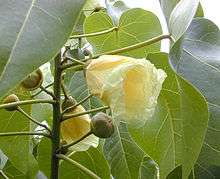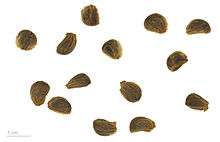Thespesia populnea
| Portia tree | |
|---|---|
 | |
| Scientific classification | |
| Kingdom: | Plantae |
| Clade: | Angiosperms |
| Clade: | Eudicots |
| Clade: | Rosids |
| Order: | Malvales |
| Family: | Malvaceae |
| Genus: | Thespesia |
| Species: | T. populnea |
| Binomial name | |
| Thespesia populnea | |
| Synonyms | |
| |

Thespesia populnea, commonly known as the Indian tulip tree, bhendi (Marathi), Pacific rosewood, or Portia tree[3] /ˈpɔːrʃə/, is species of flowering plant in the mallow family, Malvaceae. It is a small tree or arborescent shrub that has a pantropical distribution, found on coasts around the world.[4] However, the Portia tree is probably native only to the Old World,[5] and may have originated in India.[6] Nowadays, its wood is mainly used in making furniture because of its good ability to undergo carving. The wood from the tree was used by early Tamil people to make instruments in ancient Tamilakam.[7] It is possibly indigenous to the Hawaiian Islands and elsewhere in the Pacific, but may have been spread by early Polynesians for its useful wood and bast fibres.
Description
The Portia tree reaches a height of 6–10 m (20–33 ft) tall and a trunk diameter of 20–30 cm (7.9–11.8 in).[8] It grows at elevations from sea level to 275 m (902 ft)[9] in areas that receive 500–1,600 mm (20–63 in) of annual rainfall.[5] The Portia tree is able to grow in the wide range of soil types that may be present in coastal environments, including soils derived from quartz (sand), limestone, and basalt; it favours neutral soils (pH of 6–7.4).[8]
Uses
The heartwood of the Portia tree is dark reddish brown to chocolate brown and has a specific gravity of 0.55 to 0.89.[5] It is used to make the thavil, a Carnatic musical instrument of South India. Milo is popular in Hawaii for woodworking (commonly turned into bowls)[10] because of the range of colours expressed (tan, through yellow, to red). Traditionally it was planted in sacred groves and used for religious sculpture throughout eastern Polynesia. In Tahiti, Milo wood is used in the making of the to'ere (slotted wooden drum), used in traditional Tahitian tribal drumming. Makoʻi was used for the rongorongo tablets of Easter Island.[11] Since the advent of aluminium-hulled boats in the 20th century, Pitcairners have made regular trips to Henderson Island to harvest miro wood. Usually they venture to Henderson only once per year, but may make up to three trips if the weather is favourable. Pitcairners carve the wood into curios, from which they derive much of their income.[12] The flower of the Portia tree played a part in Sri Lanka's independence struggle, when it was sold on Remembrance Day by the Suriya-Mal Movement instead of the poppy to aid indigenous ex-servicemen.
_tree_in_Kolkata_W_IMG_3533.jpg)
References
- ↑ "Thespesia populnea". Germplasm Resources Information Network (GRIN). Agricultural Research Service (ARS), United States Department of Agriculture (USDA). Retrieved 2009-11-17.
- ↑ http://www.theplantlist.org/tpl/record/kew-2515863
- ↑ "Thespesia populnea". Natural Resources Conservation Service PLANTS Database. USDA. Retrieved 9 December 2015.
- ↑ Oudhia, P., 2007. Thespesia populnea (L.) Sol. ex Corrêa. [Internet] Record from PROTA4U. Louppe, D., Oteng-Amoako, A.A. & Brink, M. (Editors). PROTA (Plant Resources of Tropical Africa / Ressources végétales de l’Afrique tropicale), Wageningen, Netherlands.
- 1 2 3 Francis, John K. (2003-01-01). "Thespesia populnea (L.) Sol. ex Corrêa". Tropical Tree Seed Manual. Reforestation, Nurseries & Genetics Resources. Archived from the original (PDF) on January 16, 2009. Retrieved 2009-02-20.
- ↑ Nelson, Gil (1994). The Trees of Florida: a Reference and Field Guide. Pineapple Press Inc. p. 45. ISBN 978-1-56164-055-3.
- ↑ (Source: OED)
- 1 2 Friday, J. B.; Dana Okano (April 2006). "Thespesia populnea (milo)" (PDF). The Traditional Tree Initiative. Retrieved 2009-02-20.
- ↑ "Thespesia populnea". Hawaiian Ethnobotany Online Database. Bernice P. Bishop Museum. Retrieved 2009-02-20.
- ↑ Nelson-Kaula, Kehauwealani; Ostertag, Rebecca; Flint Hughes, R; Dudley, Bruce D (Jul 2016). "Nutrient and Organic Matter Inputs to Hawaiian Anchialine Ponds: Influences of N-Fixing and Non-N-Fixing Trees". Pacific Science. 70 (3): 333–347. doi:10.2984/70.3.5.
- ↑ Orliac, Catherine (October 2005). "The Rongorongo Tablets from Easter Island: Botanical Identification and 14C Dating". Archaeology in Oceania. 40 (3).
- ↑ Brooke, M. de L.; I. Hepburn; R.J. Trevelyan (2004). "Henderson Island World Heritage Site Management Plan 2004–2009" (PDF). Foreign and Commonwealth Office, London: 19. Archived from the original (PDF) on 2007-07-19. Retrieved 2009-03-31.
Further reading
- "Thespesia populnea". Australian Native Hibiscus and Hibiscus-like Species.
External links
| Wikimedia Commons has media related to Thespesia populnea. |
| Wikispecies has information related to Thespesia populnea |
- "Milo". Canoe Plants of Ancient Hawaiʻi. Ka ʻImi Naʻauao O Hawaiʻi Nei.
- "Thespesia populnea (L.) Sol. Ex Corr". Database of Indian Plants. Pandanus Project.
- Images on Wikipedia commons